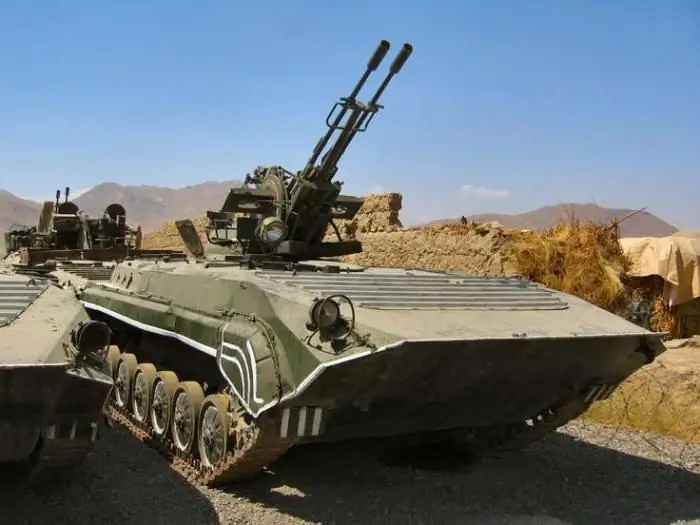2025 Author: Howard Calhoun | [email protected]. Last modified: 2025-01-24 13:10:33
During the Great Patriotic War of 1941-1945, our army faced two sad circumstances: the almost complete absence of heavy machine guns and anti-aircraft installations. No, they were in the protection of airfields, but there was often simply nothing to protect military columns on the march. As a result - a long, almost three-year dominance of fascist aviation in the air and huge losses in equipment and manpower.

That is why in the post-war years the best scientific and technical personnel of the USSR were thrown into the development of anti-aircraft artillery. The result of their work, among other things, was the ZU-23-2 anti-aircraft gun, which appeared as a result of the modernization of a simple ZU-23. It has been in service for more than 50 years, and its further development, which resulted in the twin (cannon-rocket) ZU-30, leaves no doubt about the exceptional success of the idea itself.
How did she come about?
So, after the Great Patriotic War, the entire system of anti-aircraft weapons underwent a complete revision and reorganization. It was immediately decided that 25-mm guns, due to their excess weight, were suitable exclusively for the fleet. The effectiveness of the 37-mm caliber, popular at that time, turned out to be clearly not enough to perform specific "land" tasks.
But at the same time, the troops urgently demanded a small-caliber automatic cannon, similar to those that were installed on attack aircraft during the war. Actually, the gun from the legendary Il-2 was taken as the basis. Note that the many thousands of ZU-23-2 anti-aircraft guns and their 20-mm counterparts that currently exist have become no less famous than the guns of their distant "ancestor".

Already in 1955, a project of an anti-aircraft 23-mm machine gun 2A14 was presented. The engineers proposed two configurations: single and twin. The latter immediately had an increased priority, and therefore was made in three versions at once. All varieties had only a manual drive option, equipped with a standard ZAP-23 anti-aircraft sight.
The commission decided that the ZU-14 model most fully meets all the requirements of the military. It was she who in 1959 was "driven" through all stages of combined arms tests in several military districts. It was put into service in 1960, giving the name ZU-23. Plant No. 535 was engaged in production. It should be noted that the further elimination of all identified shortcomings and "childhood diseases" took 10 years, after which the ZU-23-2 anti-aircraft gun was born.
Design features
Automation works at the expense of the energy of the discharged powder gases. The wedge-type shutter, the barrel is locked by resting its "outgrowths" in the cutouts of the receiver. luckythe design of the barrel mounts makes it possible to replace it in a combat situation in just 15-20 seconds. Also very successful were the horizontal and vertical aiming drives, equipped with spring shock-absorbing devices.

The operator spends very little time for accurate aiming at the target. If you look at the description of the ZU-23-2, which is given by the official manufacturer of these installations, then you can find information there that a trained crew can aim at a target in just 5-15 seconds. And this is subject to the use of mechanical means of correction! In the case when the soldiers have a modernized ZU-30M with optoelectronic systems at their disposal, the capture and tracking of the object is carried out almost instantly.
The trunks can be moved to the opposite side in just three seconds! Ammunition - tape type. The tape used is metal, the standard size is 50 rounds, which are packed in a metal box, which allows reloading the gun as soon as possible. Each such box with tape and cartridges weighs nearly 35.5 kg. Platform for installation - spherical, equipped with three screw jacks. With their help, the ZU-23-2 anti-aircraft gun is securely fastened in combat position.
The platform is equipped with a towing lug. In the stowed position, the installation stands on two wheels from the GAZ-69 car. There is a torsion bar suspension that serves to minimize the likelihood of damage to the gun when transporting it over rough terrain. This is an important fact,as in places of intense clashes, more or less normal roads remain extremely rare.
Guidance, shooting at different types of targets
ZU-23-2 aiming is carried out by using the ZAP-23 sight already mentioned above. The current range to the target can be entered in the range up to 3000 meters. This is true for heading 00 and ground speed of the tracked object up to 300 m/s. The sight allows you to very accurately set the required lead, which has a beneficial effect on the probability of destroying the attacked aircraft.
When shooting at ground targets, the same corrections can be made at distances up to 2000 meters. In some cases (experimental calculation), the range can be determined "manually", but usually they use the help of a stereo range finder for this. All other data is entered by the operator by eye. The angles of the target and its azimuth are especially important. Because of this, the ZU-23-2 anti-aircraft gun (we give it in the article) is very "demanding" to the presence of a well-trained crew.
A feature of this anti-aircraft gun was the fact that the design of the regular sighting system ZAP-23 includes a sight for ground targets T-3. Note that it has an independent line of sight.
Advantages of anti-aircraft guns

Oddly enough, but the ZU-23-2 anti-aircraft gun is famous not for its "air" talents, but for its ground use. In all local conflicts of recent years, it turned out that this weapon is ideally suited asthe main striking means of motorized rifle companies, since they simply have nothing more suitable. Firstly, the ZSU can be deployed almost instantly into a combat position. Secondly, with its help, all types of targets located at a direct shot distance (up to a kilometer) can be suppressed just as instantly.
Very often the need for such use of the ZU-23-2 arises in clashes with enemy irregular military formations, that is, in the course of counter-terrorist operations. Alas, over the past 20 years, they have become a real "fashion trend".
Other "highlights" of the design
The huge advantage of this installation is the fact that it does not require preliminary engineering preparation of the position. A more or less even surface is enough. Here you should take into account the possibilities of screw jacks, due to which you can even turn a slope of 30 degrees into an ideal plane. This was especially valuable in Afghanistan and Chechnya, where the ZU-23-2 23mm anti-aircraft gun was used in the mountains.
It is believed that a well-coordinated combat crew is able to bring the installation into combat position in just 15-20 seconds. From combat to marching - in 35-40 seconds. In practice, it has been proven that, if necessary, the ZU-23-2 can fire on the move, while in the stowed position. Of course, it is difficult to call accuracy and accuracy satisfactory, but it will do for an emergency battle.
Separately, you need to talk about the excellent mobility of the installation. Any army vehicle can take it in tow, since even in a fully equippedform, the mass of the memory is much less than one ton. On paved roads, the speed of transportation can reach up to 70 km/h, and off-road - up to 20 km/h. So the ZU-23-2, the technical description of which we provide, is an extremely "all-terrain" anti-aircraft gun.
A very significant advantage is also the highest maintainability. Only the simplest and most common steel grades were used in the construction, so repairs can be organized at any enterprise that has at least the most primitive machines and other equipment.
Ammunition, characteristics of cartridges

The standard ammunition load of the ZU-23-2 includes 23mm rounds. Shells are used in two types - BZT and OFZT (OFZ). The first is armor-piercing incendiary tracer. It is produced with a solid head part, the mass of which is 190 g. The bottom part contains a charge for tracing, the head part contains an incendiary composition. OFZ, that is, high-explosive fragmentation charges, have a warhead weighing 188.5 g. Until the 90s, the ZU-23-2 (a technical description of the installation is given in the article) most often used this type of ammunition.
The fuse in both cases is used brand V19UK (in early versions - MG-25). Its peculiarity lies in the presence of a self-liquidator, its response time is 11 seconds. Regardless of the brand of projectile, 77 grams of 5/7 CFL brand gunpowder is used as a propellant charge. Note that specifically for the creation of these ammunition, several domestic research institutes at once were engaged in the creation of new types of gunpowder, which wouldhad maximum energy intensity and combustion rate.
Ballistic features of ammunition
The total weight of the cartridge (regardless of the brand) is 450 g. The main ballistic indicators are also the same. The initial speed is 980 m/s, the maximum height (“ceiling”) is 1500 m, the maximum guaranteed range is up to 2000 m.
In any case, the ZU-23-2 anti-aircraft gun (we have already reviewed its characteristics) deserved a lot of criticism during both Chechen campaigns: it turned out that OFZ shells are very poorly suited for work in urban conditions, as they have poor penetration.
As a rule, the belt is loaded according to an unwritten rule: four OFZT rounds per one BZT. And further. The MG-25 fuse, which had a lot of shortcomings, has now been completely replaced by the V-19UK. The reasons for this are simple. Firstly, its sensitivity to dense surfaces is completely similar to that of the previous model, but the fuse does not detonate when the projectile comes into contact with raindrops. Secondly, it has much better moisture protection.
Combat use
The first triumphant use of the ZU-23-2 occurred during the Afghan campaign. They, due to their low weight, compactness, ease of transportation and slaughter, were ideal for covering small groups of retreating Mujahideen. Of course, Shilki played the main role in this…
That's just a self-propelled gun oneveryone was definitely not enough. First, the soldiers "semi-underground" installed "Zushki" in the back of trucks following in the military columns, and only then the ZU-23-2 in this role received official approval from the military authorities of all levels. Especially often they began to be mounted on Ural-375 and KAMAZ trucks. At the same time, it was found that five ZU-23-2 anti-aircraft guns can reliably protect a military column even from a numerous ambush, literally “crumbling” the latter in the shortest possible time.
The fact is that the BMP-1, with a cannon that had a meager angle of elevation, has become an effective means of defending military columns from Mujahideen ambushes in the mountains. Not without the participation of this weapon and the wars that unfolded in many regions of the USSR immediately after the collapse of the country. And today, ZU-23-2 anti-aircraft installations, photos of which are in the article, are full in all the "hot spots" of the world. Of recent developments, it is worth mentioning the sluggish Ukrainian conflict, in which both sides make heavy use of zushki.

And in this case, the twin anti-aircraft installation ZU-23-2 was used exclusively for work on ground targets. The sides of the confrontation no longer had a special need to knock out aircraft in the midst of hostilities (there simply weren’t any left), but during the assault on fortified points, this weapon proved to be the best.
Modern modifications
Alas, but with all its merits, even the declared effectiveness of work on air targets is small, amounting to only 0, 023. The probability of hittingin a modern aircraft (with the exception of helicopters) even lower, and significantly.
However, barrage fire from this installation has not lost its relevance, since just a couple of hits will disable almost any aircraft. The logical way out is the installation of automatic sights and target tracking systems. This is what the specialists of KB Tochmash im. A. E. Nudelman. Their work formed the basis for the emergence of new ZU-23-2 anti-aircraft guns. Photos of these models are easy to distinguish, as they contain launch containers for anti-aircraft missiles.
Advantages of upgraded models
In addition, the upgraded Zushki have electromechanical motors for guidance systems, the latest sights with illumination of the working area, a laser rangefinder that allows you to determine the distance with an accuracy of up to a meter even in poor visibility conditions. To work at night, the system can additionally be equipped with thermal imaging sights, which accurately detect the thermal radiation of enemy equipment for several kilometers. Theoretically, this allows even a modern combat helicopter to be knocked out.
The outdated sight ZAP-23 with the gunner's workplace was completely excluded from the design of the modernized anti-aircraft gun. Its place was taken by an optoelectronic module with additional guidance and control systems. The Podolsky developer claims that as a result of all these innovations, the probability of hitting a target has increased three times at once. But the real "hit" was the ZU-30M model, the design of whichprovides for the installation of MANPADS containers such as "Needle", Stinger or others, at the request of the end customer.
So the ZU-23-2 anti-aircraft gun, the characteristics of which were considered by us in the article, gave rise to the development of a whole range of simple, effective and cheap anti-aircraft guns. Being modernized, "zushka" can be used for its intended purpose for more than one year. We also note that Poland, in whose "bins" there are many such anti-aircraft guns, is arbitrarily engaged in the production of modernized models based on them. Domestic designers are very upset by the fact that the Poles do not respect copyright.

We hope that the ZU-23-2 anti-aircraft gun described by us and its performance characteristics turned out to be of interest to you. This weapon is a great example of how the initial upgrade potential allows the use of anti-aircraft guns from the Cold War and still today.
Recommended:
Thermal power plants: description, operation and technical characteristics

The article is devoted to thermal power plants. The features of such objects, the nuances of operation and maintenance are considered
Technical passport for home: how and where to make? Terms of production of a technical passport for the house

One of the main documents related to real estate is a technical passport for a house. It will be needed to carry out any transaction, and is manufactured at the BTI at the location of the facility. How much does it cost, what documents need to be collected, as well as the validity of the registration certificate and other nuances in more detail in the next material
Diesel gun: reviews and selection criteria. Diesel gun of indirect heating: technical characteristics

The diesel heat gun is ideal for quickly heating a construction site, agricultural, warehouse or industrial premises. Since its operation is carried out on diesel fuel, it consumes electricity exclusively for the operation of automation and a fan. As the main advantages of such a technological solution, one can name a relatively high thermal power with rather small dimensions
Browning machine gun: description, characteristics, photo

The Browning heavy machine gun is one of the few small guns that remains in service with the US Army to this day, having undergone minor modifications. It will be discussed in this article
Technical analysis of "Forex" (market). What is the summary technical analysis "Forex"

The Forex market has become very famous in Russia in a short time. What kind of exchange is this, how does it work, what mechanisms and tools does it have? The article reveals and describes the basic concepts of the Forex market

